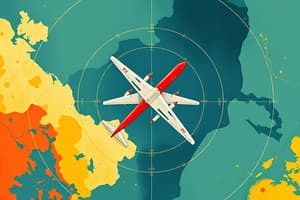Podcast
Questions and Answers
What is the speed limit at or above 10,000 MSL in the United States?
What is the speed limit at or above 10,000 MSL in the United States?
- Unrestricted (correct)
- 250 KIAS
- Mach 1
- 200 KIAS
What is the maximum speed limit below 10,000 MSL?
What is the maximum speed limit below 10,000 MSL?
- 200 KIAS
- Unrestricted
- Mach 1
- 250 KIAS (correct)
What is the speed limit within Class C, D, E or G airspace at or below 2,500 AGL?
What is the speed limit within Class C, D, E or G airspace at or below 2,500 AGL?
- 250 KIAS
- 200 KIAS (correct)
- Unrestricted
- 230 KIAS
What is the speed limit for procedure turns?
What is the speed limit for procedure turns?
When can you exceed airspeed limits?
When can you exceed airspeed limits?
What is the approach speed for Category A?
What is the approach speed for Category A?
What is the speed limit while holding at 6,001 - 14,000 ft?
What is the speed limit while holding at 6,001 - 14,000 ft?
What is the maximum holding airspeed when three minutes from a clearance limit?
What is the maximum holding airspeed when three minutes from a clearance limit?
What is the speed limit for descending below 10,000 MSL?
What is the speed limit for descending below 10,000 MSL?
The speed limit is 200 KIAS while holding at 6,000 ft MSL and below.
The speed limit is 200 KIAS while holding at 6,000 ft MSL and below.
Flashcards are hidden until you start studying
Study Notes
Airspace Speed Limits Overview
- Mach 1 is a speed limit in the United States.
- Unrestricted speed is allowed at or above 10,000 feet Mean Sea Level (MSL).
- Below 10,000 MSL, the speed limit is 250 knots indicated airspeed (KIAS).
Class B Airspace Regulations
- Unrestricted speed at or above 10,000 MSL.
- 250 KIAS limit applies below 10,000 MSL.
Speed Limits in Specific Areas
- Beneath Class B or in VFR corridors through Class B, the speed limit is 200 KIAS.
- Procedure turns have a speed limit of 200 KIAS.
- In Class C or D airspace, at or below 2,500 feet Above Ground Level (AGL) within 4 nautical miles of the airport, speed is limited to 200 KIAS unless otherwise directed by Air Traffic Control (ATC).
- Recommended 200 KIAS in Class E or G airport traffic patterns.
Exceeding Airspeed Limits
- Per regulation 91.117(d), exceed airspeed limits if the minimum safe airspeed for the operation requires it, without needing to notify ATC.
ATC Speed Limits
- When ATC issues a speed limit while vectoring, continue to comply even with changes in altitude.
Key Speed Limit Exceptions
- Below 10,000 MSL and/or in Class B, the speed limit remains 250 KIAS, even when instructed to maintain best forward speed.
- At 10,000 MSL and above within Class B airspace, speeds are unrestricted.
Descending and Transitions
- While descending from above 10,000 MSL to below, the aircraft must be at or below 250 KIAS before entering Class B airspace.
Coastal Airspace Considerations
- The 250 KIAS limit below 10,000 does not apply beyond 12 nautical miles from the coastline.
Provisions within 4 Nautical Miles
- Within 4 NM of Class C, D, E, or G at or below 2,500 AGL, the speed limit is also 200 KIAS.
Holding Pattern Speed Limits
- At 6,000 feet MSL and below, speed is limited to 200 KIAS.
- Holding at altitudes from 6,001 to 14,000 feet has a speed limit of 230 KIAS.
- Above 14,001 feet, the holding speed limit is 265 KIAS, maintaining a 1.5-minute outbound leg.
Approaching Clearance Limits
- When three minutes from a clearance limit, reduce speed to not exceed maximum holding airspeed or sooner to avoid holding altogether.
Approach Speeds by Category
- Category A: 0-90 Knots (1.3 times Vso)
- Category B: 91-120 Knots (1.3 times Vso)
- Category C: 121-140 Knots (1.3 times Vso)
- Category D: 141-165 Knots (1.3 times Vso)
- Category E: Above 165 Knots (1.3 times Vso)
Studying That Suits You
Use AI to generate personalized quizzes and flashcards to suit your learning preferences.



